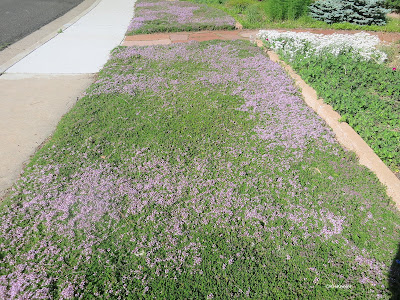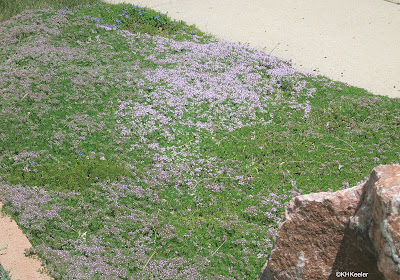My yard has very little lawn, meaning areas with a monoculture of grass. Northern Colorado is too dry for standard varieties of Kentucky bluegrass, so having extensive grass wasn't water-efficient, and when we moved here, I was very conscious of the low rainfall of the region. Secondly, the need to keep a grass lawn mowed meant that the shaggy lawn would signal that we were away, back when we took extended trips. Third, my husband, the chief lawn-mower, didn't enjoy the activity.
 |
| Thyme lawn |
The rest of the growing season there are small green leaves, or kind of beige tiny seed heads from the smaller thyme (mother-of-thyme). The picture below has the speedwells in bloom (blue-purple area in center of photo) but shows the leaf color well.
 |
| Thyme lawn with pine needles and a bee |
 |
| Grass lawn I had once: not well-fertilized but only small weeds. |
We had extensive grass lawns when I was a child. I have an aesthetic that likes monoculture green lawns, linear edges, and the like. But nature doesn't grow like that and so yard care is a continual battle to keep the edges neat, stop invasion by weeds, etc. I would prefer a yard that matched the plants in it, where the columbines are welcome wherever they grow (they like my paths) and the speedwell can move in with the creeping juniper. The tension for me is frequently about how much order to impose and how much chaos I can live with.
In Switzerland a couple years ago, I was struck by the fact that their lawns tended to be a mix of grass and what I thought of as weeds. Very few lawns were grass monoculture perfection. Many of the weeds were the same plants we have invading grass lawns in the U.S., for example dandelions (Taraxacum officinale) and plantain (Plantago major). In Switzerland, those are natives. You can call them weeds, since weeds are "plants in the wrong place" (a peculiarly human-centric definition), but you can also call them wildflowers. Where did we get to thinking that a lawn was best when there was only a single species of grass? Grass and wildflowers seem a pleasant combination whether you sometimes walk or play croquet on it, lie down to read in the shade, or, I suppose, graze your goat. Keeping out everything but one grass species is a lot of work for a dubious aethetic.
 |
| Lawn in Switzerland with lots of "weeds" |
There is no way I can ignore dandelions because they'll invade my neighbors' more classical lawns, but in the grass lawn in the back yard, I tolerate a lot of miscellaneous small plants. Writing this makes me wonder what creeping natives I could add to the thyme lawn.
Plants are a hobby of mine, so I will of course try new ones, cut some for flowers indoors, and sit and watch their pollinators visit. Minimizing the work so I can just play when I'm in the yard--that would be great. For that, I am continually questioning the aesthetic driving my choices. The thyme lawn and a relaxed attitude toward the mix of plants that is my grass lawn have been successful changes.
Comments and corrections welcome.
 |
| Two thymes and a speedwell |
Two thymes and a speedwell: In the photo above you can see the larger-flowered thyme creeping thyme (Thymus serpyllum) in the upper center, the tiny-flowered mother-of-thyme (Thymus praecox) covering the left half of the flowerbed, and a small patch of Turkish speedwell (Veronica liwanensis) along the top of the photo, betweed mother-of-thyme and the sidewalk. The flowers of Turkish speedwell are quite blue and bigger than those of either thyme, but not so dense and hard to see in this photo.
Kathy Keeler, A Wandering Botanist
More at awanderingbotanist.com
Join me on Facebook: https://www.facebook.com/AWanderingBotanist


How have your neighbors been about your thyme lawn? I'd like to get rid of our grass out front too. It's not doing well. But I am a little afraid of the HOA/neighbors freaking out over it.
ReplyDeleteEven the neighbor with the putting-green lawn had no objection to the thyme lawn. My neighborhood doesn't have an HOA, however. You'd be wise to talk to them. In Colorado, state statutes encouraging xeriscape (water efficiency) have superseded older rules; acceptable is a moving target. The thyme lawn looks like/is a flowerbed.
DeleteWhen you planted thyme, how did you get rid of bluegrass? I would love to plant thyme in random places and think that it would "take over". Is that wishful thinking? You say you eliminated the front lawn. I need some more words for that. What did that entail?
ReplyDeleteI hired contractors who brought a turf-cutter (rented, I think) which cut the turf so it could be rolled up and carried away. See online videos. I have done the same thing with a spade, but it is hard work. I'm not sure how you'd set conditions so that the thyme prospered and the grass did not. You'd probably have a mix of thyme and grass for years.
ReplyDelete